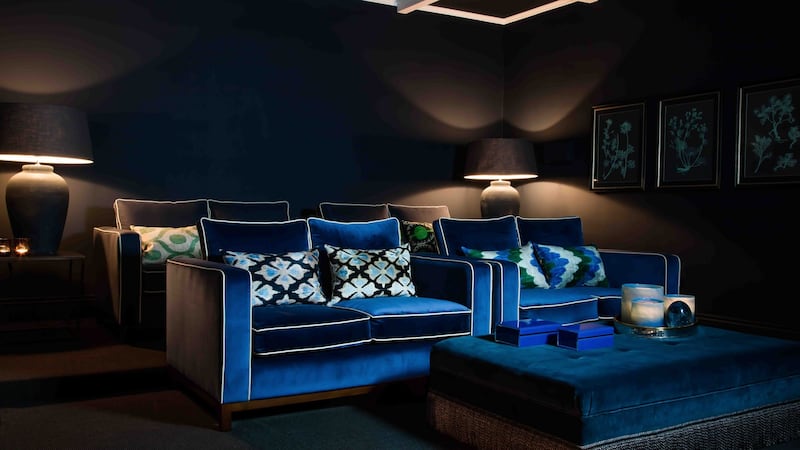It is a sign of the times that interior designer Helen Turkington's swish new showrooms in Sandyford features a luxurious cinema room that is secreted from view behind floor-to-ceiling velvet curtains that envelop the space.
Very gently tiered, with deep pile, double sofas, in midnight blue velvet, banked on each level, it is a tabernacle to the screen and is a feature that the designer is installing into many of her clients’ new-build properties, those measuring 278sq m /3,000 square feet and over.
While Turkinton’s room is incredibly polished, the idea is a simple one. It is a blackened space devoid of windows. In new-build homes, she suggests creating a basement, and installing air-conditioning to ensure continuous air flow. Other than that, it’s about creating a tactile environment that feels sumptuous, a place you will want to spend time in.
But before you even look at fabric swatches, make sure your home has decent wireless broadband speeds, cautions Alan Cloney of Blackrock-based Cloney Audio. "Some of the best addresses in the city have terrible broadband signals, so before you invest, ask your service provider what the strength of your incoming signal is."
Cloney Audio does house calls within the greater Dublin area. “It may take four or five meetings plus drawings before we can even quote a job but it can result in a fantastic viewing experience when it is done right.”
Pak-Edge and Ubiquiti Networks are two systems that Cloney works with, with the latter already supplying numerous pubs and restaurants across the country. Either will cost from €1,500 upwards.
Costs wise you will also need to hire an electrician to install high speed cabling to facilitate the signal.
Authentic experience
In order to create an authentic cinematic experience, akin to going to the cinema, you should opt for a projector rather than a TV, says Cloney. An entry level projector will cost upwards of €1,000. Prices for a fixed projector screen start from €750. Be mindful that with bigger screen televisions it is harder to retain the high definition resolution, he says.

Then you need to factor in sound quality. A sound bar will help give you deep baritone boom that we’ve come to expect from a night at the flicks. Entry level examples cost from €800 while prices start from about €2,000 for a full surround sound system.
The last thing to consider is universal control, just one remote to deal with the lights, heating, curtains, blinds and screens. If you're still operating several remotes, interior designer Collette Ward, who created the show house at last season's Ideal Homes Show, suggests keeping them in a box to prevent one from slipping down the side of the sofa or disappearing into the mouth of your pet dog, something she says that happens a lot more often that you'd think.
Half of Ward's clients want a home cinema, especially the empty nesters, she says. "In essence, it's a luxurious cave where Netflix is now life to everyone. You need to create a sense of luxury by layering colour and fabrics. Paper-backed fabrics can help dampen down sound. Stereo or Cole & Son, sell several design options."
Windows should get the same treatments as walls and if you add remote-controlled black-out blinds and curtains, you can ready the room from a reclined position. “The look should make you feel shrouded and cocooned, so go for matchy-matchy curtains and walls. This isn’t a room that you want to create contrast in.”
Ward also suggests carpeting the floor. It helps soften the sound and you can layer it up with a rug atop and even add snuggly blankets, cushions and throws. You can add pattern here to create visual interest as it won’t distract from what’s on screen.
For this idea, Ward likes to use Roche Bobois's classic Mah Jong, especially its Kenzo fabrics. "It's a really effective and sophisticated floor cushion that you can layer up or down depending on how horizontal you want to get."
'Pillow-like' velvet sofas
Helen Turkington suggests velvet sofas with leather piping because the fabric has "a pillow-like" feel. Her sofa seats are about six inches deeper than standard, so you could, if you had four in your home and belonged to a family of four, each have a whole two-seat sofa to stretch out on.
Lighting is also important. Ward’s solution is to install wall lights to the back of the room, using shades made from the same fabric as the walls. This allows the room some diffuse light. Turkington likes to use simple plaster wall lights that can be painted the same colour as the scheme.
Don’t be swayed by interior designers who say you need to hide the speakers, is Cloney’s last word on the subject. This is a room where you are meant to have the technology on show.”











